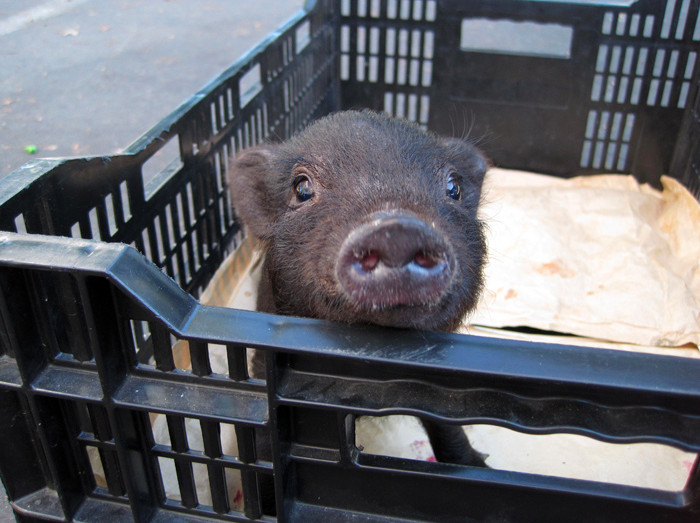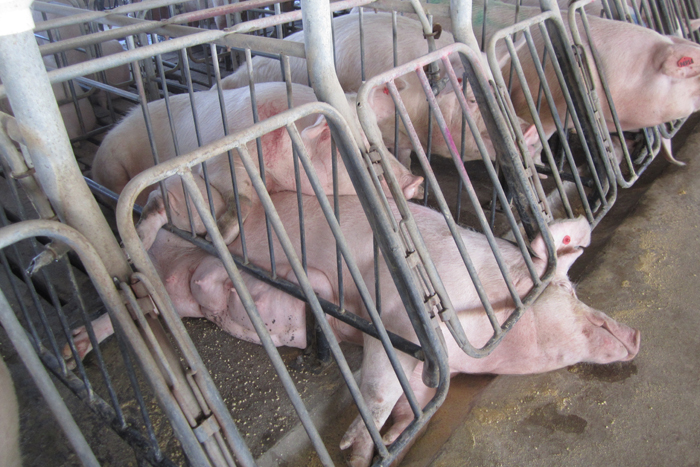Pork Producers Prohibit Painful Pig Pens (Op-Ed)


Matthew Prescott is food policy director for The Humane Society of the United States. He contributed this article to Live Science's Expert Voices: Op-Ed & Insights.
Recently, Cargill — America's largest private corporation — rocked the food world when it announced plans to eliminate gestation crates from its supply system. Gestation crates are tiny cages that confine pigs so restrictively they can barely move an inch during their entire lives. The crates, about two feet wide by seven feet long, are roughly the same dimensions as a pregnant sow’s own body, preventing her from even turning around.
The life cycle of a confined breeding sow is as such: the animal is locked inside a gestation crate and impregnated. For the four months she is gestating, the sow lingers in the cage, essentially immobilized, day and night. As she prepares to give birth, she is transferred to a different — albeit similarly restrictive cage — called a farrowing crate. She spends a few short weeks weaning her piglets there, is re-impregnated and put back into a gestation crate. The cycle repeats for nearly four years, after which the animal is sent to slaughter.
This announcement from Cargill is the latest in a series of triumphs for animal protection advocates , veterinarians, food companies and other pork-production stakeholders who oppose enclosing animals to such an extreme degree.
"We believe it is the right thing to do for the long term future of pork production in the U.S., and our customers agree with us and support our decision," said Mike Luker, president of Cargill Pork.
Luker is right. Putting aside for a moment the animal-welfare implications of locking animals in cages and lining them up like parked cars, the industry's trajectory is clear if it wants to remain a competitive American enterprise. In the past two years alone, dozens of global food companies — including McDonald's, Burger King, Costco, Kroger, Safeway, Oscar Mayer and about 60 others — have announced they intend to drop from their supply chains pork producers that use gestation crates.
Jeff Worstell, vice president of livestock production for Cargill Pork, put it best: "If you want to be a viable supplier, you respond to the signals your customers send."
Get the world’s most fascinating discoveries delivered straight to your inbox.
Temple Grandin, a well-known and highly regarded pork-industry animal welfare expert, believes the crates have "got to go." In Improving Animal Welfare: A Practical Approach, a text book she edited, Grandin said: "Confining an animal for most of its life in a box in which it is not able to turn around does not provide a decent life."
The latest scientific reviews of this issue support her view. For example, when the Prairie Swine Center, a prestigious pork industry research firm, compared animal housing systems that confine pigs in gestation crates with "group housing," which allows pigs greater freedom of movement, their study concluded that "better welfare can be achieved when sows are not confined throughout gestation." As the report found, “Research comparing group housed sows to those in crates found that the animals unable to exercise due to stall confinement have lower bone strength, muscle mass, and decreased physical fitness and cardiovascular health.”
After the Pew Commission on Industrial Farm Animal Production — a panel including farmers, veterinarians and former Agriculture Secretary Dan Glickman — studied the issue, it recommended the “phase-out, within 10 years, of all intensive confinement systems that restrict natural movement and normal behaviors, including swine gestation crates.”
Science plus consumer support have motivated some major pork producers to move toward group housing. In 2007, Smithfield Foods — the world's largest pork producer — announced that it would eliminate gestation crates from all company-owned barns; earlier this year, it extended that commitment to affect all the contractors producing piglets for the company. In 2012, Hormel Foods, the maker of SPAM, followed suit. And last January, Tyson Foods announced it had advised the farmers in its system that future sow housing should allow animals to turn around and engage in other natural behaviors that gestation-crate confinement prevents.
As encouraging as this movement is, it still is not universal. Others in the pork industry still resist what their customers demand.
"So our animals can’t turn around for the 2.5 years that they are in the stalls producing piglets," Dave Warner, spokesman for the National Pork Producers Council, once remarked in a National Journal interview. "I don’t know who asked the sow if she wanted to turn around."
Warner's and the Pork Council's callous statements about how animals should be treated are out of step with both what mainstream Americans want for animals, and what 21st-century science tells us animals need.
Cargill's announcement is one more blow to the pork industry’s most extreme form of routine abuse. Now, industry holdouts like Seaboard Foods, The National Pork Producers Council and the National Pork Board have a choice: They can continue to defend outdated practices and risk turning away even more customers, or join the momentum and switch to group housing.
Scientists, veterinarians and the world's largest food brands — not to mention several top producers like Cargill — have made it clear that gestation crates are outdated, and on their way out. Those of us in a civil society who value a healthy, sustainable food system — one that treats animals as more than factory widgets — believe that this move toward a more humane way of farming and eating is long overdue and most welcome.
Follow all of the Expert Voices issues and debates — and become part of the discussion — on Facebook, Twitter and Google +. The views expressed are those of the author and do not necessarily reflect the views of the publisher. This version of the article was originally published on Live Science.




